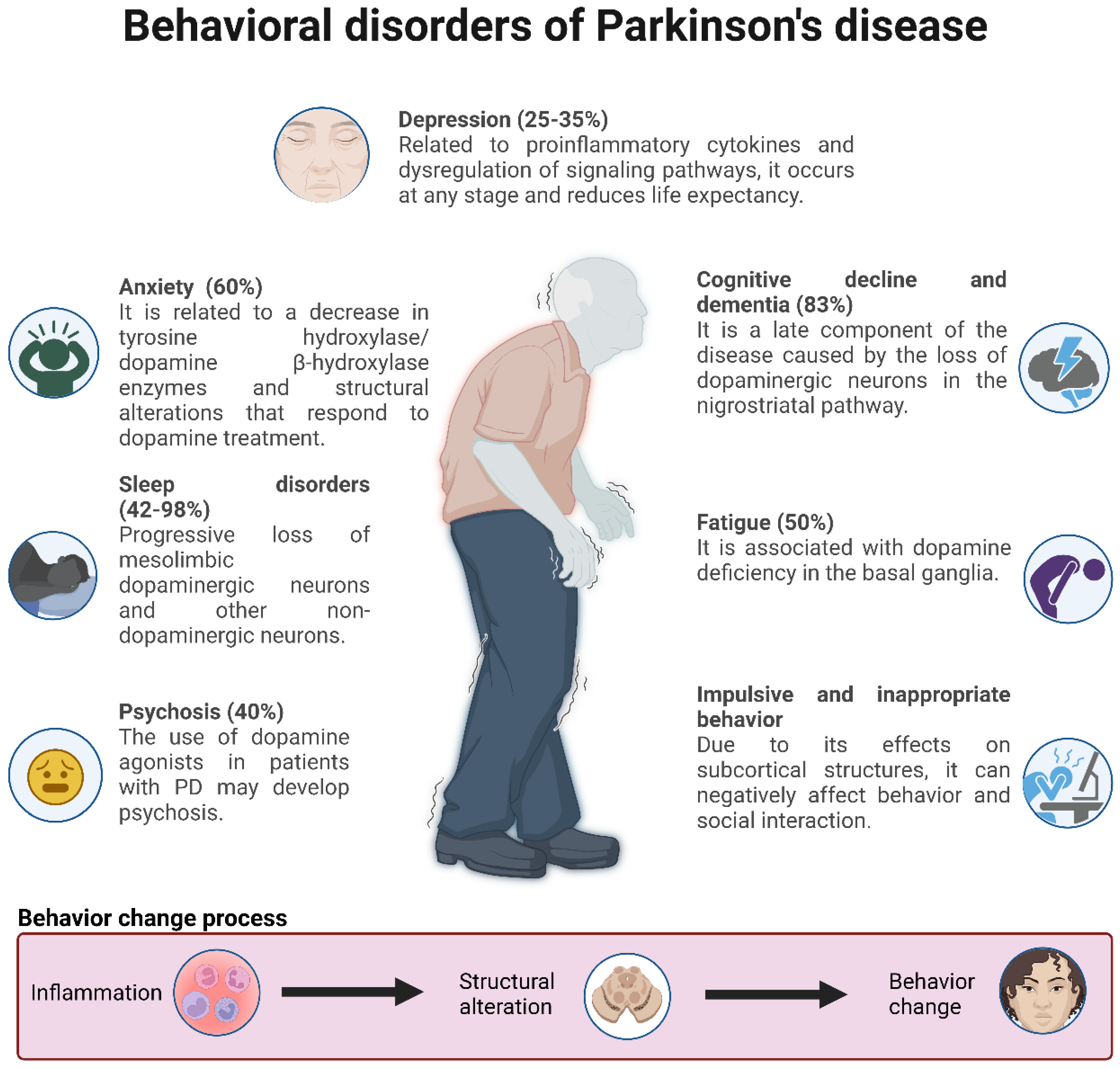Neuroinflammation in Parkinson’s Disease: From Gene to Clinic: A Systematic Review
Abstract
1. Introduction
2. Materials and Methods
2.1. Objective
2.2. Search Strategies
2.3. Selection of Studies
3. Results
3.1. Genetic and Molecular Alterations of Parkinson’s Disease Associated with Neuroinflammation
3.1.1. Autosomal Dominant PD
SNCA Gene
LRRK2 (Leucine-Rich Repeat Kinase 2)
VPS35
GBA1 (Glucosylceramidase Beta 1)
3.1.2. Autosomal Recessive PD
PRKN (Parkin)
PINK1 (Putative PTEN-Induced Kinase 1)
DJ-1 (Daisuke-Junko-1)
3.2. Cellular and Tissue Alterations of Parkinson’s Disease Associated with Neuroinflammation
3.2.1. Alterations in Lipid Disposition
3.2.2. Mitochondrial Alterations and Oxidative Stress
3.2.3. Dopaminergic Neuron Alterations and with Neuromelanin
3.2.4. Glial Activation
3.2.5. Endothelial Cell Activation
3.2.6. Adaptive Immune Cell Response
3.3. Anatomopathological Alterations of Parkinson’s Disease Associated with Neuroinflammation
3.3.1. Gliosis
3.3.2. Pathology through α-syn
3.3.3. Death of DA Neurons
3.3.4. Infectious Factors
3.3.5. Peripheral Nervous System (PNS) Alterations
3.4. Behavioral Alterations of Parkinson’s Disease and Lifestyles Associated with Neuroinflammation
3.4.1. Diet
3.4.2. Physical Activity and Exercise
3.4.3. Stress and Comorbidities
3.4.4. Non-Motor Alterations Associated with Neuroinflammation in PD
Depression and Anxiety
Sleep Disorders
Cognitive Decline and Dementia
Psychosis and Impulsive Behaviors
4. Discussion
5. Conclusions
Supplementary Materials
Author Contributions
Funding
Institutional Review Board Statement
Informed Consent Statement
Data Availability Statement
Acknowledgments
Conflicts of Interest
Correction Statement
References
- Vásquez-Celaya, L.; Marín, G.; Hernández, M.; Carrillo, P.; Pérez, C.; Coria-Avila, G.; Manzo, J.; Miquel, M.; García, L. Functional correlation between cerebellum and basal ganglia: A parkinsonism model. Neurología 2022. [Google Scholar] [CrossRef]
- Darweesh, S.K.; Raphael, K.G.; Brundin, P.; Matthews, H.; Wyse, R.K.; Chen, H.; Bloem, B.R. Parkinson Matters. JPD 2018, 8, 495–498. [Google Scholar] [CrossRef]
- Simon, D.K.; Tanner, C.M.; Brundin, P. Parkinson Disease Epidemiology, Pathology, Genetics, and Pathophysiology. Clin. Geriatr. Med. 2020, 36, 1–12. [Google Scholar] [CrossRef] [PubMed]
- Barnhill, L.M.; Murata, H.; Bronstein, J.M. Studying the Pathophysiology of Parkinson’s Disease Using Zebrafish. Biomedicines 2020, 8, 197. [Google Scholar] [CrossRef] [PubMed]
- Marín, G.; Rangel, C.C.; Lara, L.S.; Quesada, L.A.V.; Calderon, C.Z.; Low, C.D.B.; Abraham, J.E.S.; Avila, G.A.C.; Manzo, J.; Hernández, L.I.G. Deep brain stimulation in neurological diseases and other pathologies. Neurol. Perspect. 2022, 2, 151–159. [Google Scholar] [CrossRef]
- Parkinson, J. An Essay on the Shaking Palsy. JNP 2002, 14, 223–236. [Google Scholar] [CrossRef] [PubMed]
- Hirsch, E.C.; Standaert, D.G. Ten Unsolved Questions About Neuroinflammation in Parkinson’s Disease. Mov. Disord. 2021, 36, 16–24. [Google Scholar] [CrossRef]
- Gelders, G.; Baekelandt, V.; Van Der Perren, A. Linking Neuroinflammation and Neurodegeneration in Parkinson’s Disease. J. Immunol. Res. 2018, 2018, 4784268. [Google Scholar] [CrossRef]
- Atri, A. The Alzheimer’s Disease Clinical Spectrum. Med. Clin. N. Am. 2019, 103, 263–293. [Google Scholar] [CrossRef] [PubMed]
- Page, M.J.; McKenzie, J.E.; Bossuyt, P.M.; Boutron, I.; Hoffmann, T.C.; Mulrow, C.D.; Shamseer, L.; Tetzlaff, J.M.; Akl, E.A.; Brennan, S.E.; et al. The PRISMA 2020 statement: An updated guideline for reporting systematic reviews. BMJ 2021, 88, n71. [Google Scholar] [CrossRef]
- Stoker, T.B.; Greenland, J.C. (Eds.) Parkinson’s Disease: Pathogenesis and Clinical Aspects; Codon Publications: Singapore, 2018; Available online: https://exonpublications.com/index.php/exon/issue/view/9 (accessed on 10 December 2023).
- Wang, T.; Zhang, J.; Xu, Y. Epigenetic Basis of Lead-Induced Neurological Disorders. Int. J. Environ. Res. Public Health 2020, 17, 4878. [Google Scholar] [CrossRef]
- Blauwendraat, C.; Nalls, M.A.; Singleton, A.B. The genetic architecture of Parkinson’s disease. Lancet Neurol. 2020, 19, 170–178. [Google Scholar] [CrossRef] [PubMed]
- Fecchio, C.; Palazzi, L.; de Laureto, P.P. α-Synuclein and Polyunsaturated Fatty Acids: Molecular Basis of the Interaction and Implication in Neurodegeneration. Molecules 2018, 23, 1531. [Google Scholar] [CrossRef] [PubMed]
- Ma, L.; Yang, C.; Zhang, X.; Li, Y.; Wang, S.; Zheng, L.; Huang, K. C-terminal truncation exacerbates the aggregation and cytotoxicity of α-Synuclein: A vicious cycle in Parkinson’s disease. Biochim. Biophys. Acta Mol. Basis Dis. 2018, 1864, 3714–3725. [Google Scholar] [CrossRef] [PubMed]
- Karimi-Moghadam, A.; Charsouei, S.; Bell, B.; Jabalameli, M.R. Parkinson Disease from Mendelian Forms to Genetic Susceptibility: New Molecular Insights into the Neurodegeneration Process. Cell. Mol. Neurobiol. 2018, 38, 1153–1178. [Google Scholar] [CrossRef] [PubMed]
- Gómez-Benito, M.; Granado, N.; García-Sanz, P.; Michel, A.; Dumoulin, M.; Moratalla, R. Modeling Parkinson’s Disease with the Alpha-Synuclein Protein. Front. Pharmacol. 2020, 11, 356. [Google Scholar] [CrossRef] [PubMed]
- Zeng, X.-S.; Geng, W.-S.; Jia, J.-J.; Chen, L.; Zhang, P.-P. Cellular and Molecular Basis of Neurodegeneration in Parkinson Disease. Front. Aging Neurosci. 2018, 10, 109. [Google Scholar] [CrossRef]
- Coskuner-Weber, O.; Uversky, V. Insights into the Molecular Mechanisms of Alzheimer’s and Parkinson’s Diseases with Mo-lecular Simulations: Understanding the Roles of Artificial and Pathological Missense Mutations in Intrinsically Disordered Proteins Related to Pathology. IJMS 2018, 19, 336. [Google Scholar] [CrossRef]
- Xia, N.; Cabin, D.E.; Fang, F.; Reijo Pera, R.A. Parkinson’s Disease: Overview of Transcription Factor Regulation, Genetics, and Cellular and Animal Models. Front Neurosci. 2022, 16, 894620. [Google Scholar] [CrossRef]
- Du, X.Y.; Xie, X.X.; Liu, R.T. The Role of α-Synuclein Oligomers in Parkinson’s Disease. IJMS 2020, 21, 8645. [Google Scholar] [CrossRef]
- Selvaraj, S.; Piramanayagam, S. Impact of gene mutation in the development of Parkinson’s disease. Genes Dis. 2019, 6, 120–128. [Google Scholar] [CrossRef]
- Lamonaca, G.; Volta, M. Alpha-Synuclein and LRRK2 in Synaptic Autophagy: Linking Early Dysfunction to Late-Stage Pa-thology in Parkinson’s Disease. Cells 2020, 9, 1115. [Google Scholar] [CrossRef] [PubMed]
- Pajarillo, E.; Rizor, A.; Lee, J.; Aschner, M.; Lee, E. The role of posttranslational modifications of α-synuclein and LRRK2 in Par-kinson’s disease: Potential contributions of environmental factors. Biochim. Biophys. Acta Mol. Basis Dis. 2019, 1865, 1992–2000. [Google Scholar] [CrossRef] [PubMed]
- Myasnikov, A.; Zhu, H.; Hixson, P.; Xie, B.; Yu, K.; Pitre, A.; Peng, J.; Sun, J. Structural analysis of the full-length human LRRK2. Cell 2021, 184, 3519–3527.e10. [Google Scholar] [CrossRef] [PubMed]
- Lesage, S.; Houot, M.; Mangone, G.; Tesson, C.; Bertrand, H.; Forlani, S.; Anheim, M.; Brefel-Courbon, C.; Broussolle, E.; Thobois, S.; et al. Genetic and Phenotypic Basis of Autosomal Dominant Parkinson’s Disease in a Large Multi-Center Cohort. Front. Neurol. 2020, 11, 682. [Google Scholar] [CrossRef] [PubMed]
- Park, J.-S.; Davis, R.L.; Sue, C.M. Mitochondrial Dysfunction in Parkinson’s Disease: New Mechanistic Insights and Therapeutic Perspectives. Curr. Neurol. Neurosci. Rep. 2018, 18, 21. [Google Scholar] [CrossRef]
- Larsen, S.B.; Hanss, Z.; Krüger, R. The genetic architecture of mitochondrial dysfunction in Parkinson’s disease. Cell Tissue Res. 2018, 373, 21–37. [Google Scholar] [CrossRef] [PubMed]
- Borsche, M.; Pereira, S.L.; Klein, C.; Grünewald, A. Mitochondria and Parkinson’s Disease: Clinical, Molecular, and Translational Aspects. JPD 2021, 11, 45–60. [Google Scholar] [CrossRef]
- Chen, Y.; Sam, R.; Sharma, P.; Chen, L.; Do, J.; Sidransky, E. Glucocerebrosidase as a therapeutic target for Parkinson’s disease. Expert Opin. Ther. Targets 2020, 24, 287–294. [Google Scholar] [CrossRef]
- Do, J.; McKinney, C.; Sharma, P.; Sidransky, E. Glucocerebrosidase and its relevance to Parkinson disease. Mol. Neurodegener. 2019, 14, 36. [Google Scholar] [CrossRef] [PubMed]
- Li, H.; Ham, A.; Ma, T.C.; Kuo, S.H.; Kanter, E.; Kim, D.; Ko, H.S.; Quan, Y.; Sardi, S.P.; Li, A.; et al. Mitochondrial dysfunction and mitophagy defect triggered by hetero-zygous GBA mutations. Autophagy 2019, 15, 113–130. [Google Scholar] [CrossRef]
- Riboldi, G.M.; Di Fonzo, A.B. GBA, Gaucher Disease, and Parkinson’s Disease: From Genetic to Clinic to New Therapeutic Ap-proaches. Cells 2019, 8, 364. [Google Scholar] [CrossRef] [PubMed]
- Senkevich, K.A.; Kopytova, A.E.; Usenko, T.S.; Emelyanov, A.K.; Pchelina, S.N. Parkinson’s Disease Associated with GBA Gene Mu-tations: Molecular Aspects and Potential Treatment Approaches. Acta Nat. 2021, 13, 70–78. [Google Scholar] [CrossRef]
- García-Sanz, P.; Orgaz, L.; Fuentes, J.M.; Vicario, C.; Moratalla, R. Cholesterol and multilamellar bodies: Lysosomal dysfunction in GBA-Parkinson disease. Autophagy 2018, 14, 717–718. [Google Scholar] [CrossRef]
- Prasuhn, J.; Brüggemann, N. Genotype-driven therapeutic developments in Parkinson’s disease. Mol. Med. 2021, 27, 42. [Google Scholar] [CrossRef]
- Oyarzún, J.E.; Lagos, J.; Vázquez, M.C.; Valls, C.; De la Fuente, C.; Yuseff, M.I.; Alvarez, A.R.; Zanlungo, S. Lysosome motility and distribution: Relevance in health and disease. Biochim. Biophys. Acta Mol. Basis Dis. 2019, 1865, 1076–1087. [Google Scholar] [CrossRef] [PubMed]
- Tan, S.H.; Karri, V.; Tay, N.W.; Chang, K.H.; Ah, H.Y.; Ng, P.Q.; San Ho, H.; Keh, H.W.; Candasamy, M. Emerging pathways to neurodegeneration: Dissecting the critical molecular mechanisms in Alzheimer’s disease, Parkinson’s disease. Biomed. Pharmacother. 2019, 111, 765–777. [Google Scholar] [CrossRef]
- Barazzuol, L.; Giamogante, F.; Brini, M.; Calì, T. PINK1/Parkin Mediated Mitophagy, Ca2+ Signalling, and ER–Mitochondria Contacts in Parkinson’s Disease. IJMS 2020, 21, 1772. [Google Scholar] [CrossRef]
- Aryal, B.; Lee, Y. Disease model organism for Parkinson disease: Drosophila melanogaster. BMB Rep. 2019, 52, 250–258. [Google Scholar] [CrossRef] [PubMed]
- Lin, K.J.; Lin, K.L.; Chen, S.D.; Liou, C.W.; Chuang, Y.C.; Lin, H.Y.; Lin, T.K. The Overcrowded Crossroads: Mitochondria, Alpha-Synuclein, and the Endo-Lysosomal System Interaction in Parkinson’s Disease. IJMS 2019, 20, 5312. [Google Scholar] [CrossRef] [PubMed]
- Miller, S.; Muqit, M.M.K. Therapeutic approaches to enhance PINK1/Parkin mediated mitophagy for the treatment of Parkinson’s disease. Neurosci. Lett. 2019, 705, 7–13. [Google Scholar] [CrossRef] [PubMed]
- Junqueira, S.C.; Centeno, E.G.Z.; Wilkinson, K.A.; Cimarosti, H. Post-translational modifications of Parkinson’s disease-related pro-teins: Phosphorylation, SUMOylation and Ubiquitination. Biochim. Biophys. Acta Mol. Basis Dis. 2019, 1865, 2001–2007. [Google Scholar] [CrossRef]
- Bandres-Ciga, S.; Diez-Fairen, M.; Kim, J.J.; Singleton, A.B. Genetics of Parkinson’s disease: An introspection of its journey towards precision medicine. Neurobiol. Dis. 2020, 137, 104782. [Google Scholar] [CrossRef] [PubMed]
- Weng, M.; Xie, X.; Liu, C.; Lim, K.L.; Zhang C wu Li, L. The Sources of Reactive Oxygen Species and Its Possible Role in the Path-ogenesis of Parkinson’s Disease. Park. Dis. 2018, 2018, 9163040. [Google Scholar]
- Alarcon-Gil, J.; Sierra-Magro, A.; Morales-Garcia, J.A.; Sanz-SanCristobal, M.; Alonso-Gil, S.; Cortes-Canteli, M.; Niso-Santano, M.; Martínez-Chacón, G.; Fuentes, J.M.; Santos, A.; et al. Neuroprotective and Anti-Inflammatory Effects of Linoleic Acid in Models of Parkinson’s Disease: The Implication of Lipid Droplets and Lipophagy. Cells 2022, 11, 2297. [Google Scholar] [CrossRef]
- Fais, M.; Dore, A.; Galioto, M.; Galleri, G.; Crosio, C.; Iaccarino, C. Parkinson’s Disease-Related Genes and Lipid Alteration. Int. J. Mol. Sci. 2021, 22, 7630. [Google Scholar] [CrossRef]
- Arena, G.; Sharma, K.; Agyeah, G.; Krüger, R.; Grünewald, A.; Fitzgerald, J.C. Neurodegeneration and Neuroinflammation in Par-kinson’s Disease: A Self-Sustained Loop. Curr. Neurol. Neurosci. Rep. 2022, 22, 427–440. [Google Scholar] [CrossRef] [PubMed]
- Portz, P.; Lee, M. Changes in Drp1 Function and Mitochondrial Morphology Are Associated with the α-Synuclein Pathology in a Transgenic Mouse Model of Parkinson’s Disease. Cells 2021, 10, 885. [Google Scholar] [CrossRef]
- Rey, F.; Ottolenghi, S.; Giallongo, T.; Balsari, A.; Martinelli, C.; Rey, R.; Allevi, R.; Giulio, A.M.; Zuccotti, G.V.; Mazzucchelli, S.; et al. Mitochondrial Metabolism as Target of the Neuropro-tective Role of Erythropoietin in Parkinson’s Disease. Antioxidants 2021, 10, 121. [Google Scholar] [CrossRef] [PubMed]
- Xia, M.-L.; Xie, X.-H.; Ding, J.-H.; Du, R.-H.; Hu, G. Astragaloside IV inhibits astrocyte senescence: Implication in Parkinson’s disease. J. Neuroinflammation 2020, 17, 105. [Google Scholar] [CrossRef]
- Vila, M. Neuromelanin, aging, and neuronal vulnerability in Parkinson’s disease. Mov Disord. 2019, 34, 1440–1451. [Google Scholar] [CrossRef] [PubMed]
- Carballo-Carbajal, I.; Laguna, A.; Romero-Giménez, J.; Cuadros, T.; Bové, J.; Martinez-Vicente, M.; Parent, A.; Gonzalez-Sepulveda, M.; Peñuelas, N.; Torra, A.; et al. Brain tyrosinase overex-pression implicates age-dependent neuromelanin production in Parkinson’s disease pathogenesis. Nat. Commun. 2019, 10, 973. [Google Scholar] [CrossRef] [PubMed]
- Chu, H.-Y. Synaptic and cellular plasticity in Parkinson’s disease. Acta Pharmacol. Sin. 2020, 41, 447–452. [Google Scholar] [CrossRef] [PubMed]
- Guatteo, E.; Berretta, N.; Monda, V.; Ledonne, A.; Mercuri, N.B. Pathophysiological Features of Nigral Dopaminergic Neurons in Animal Models of Parkinson’s Disease. Int. J. Mol. Sci. 2022, 23, 4508. [Google Scholar] [CrossRef] [PubMed]
- Di Martino, R.; Sisalli, M.J.; Sirabella, R.; Della Notte, S.; Borzacchiello, D.; Feliciello, A.; Annunziato, L.; Scorziello, A. Ncx3-Induced Mitochondrial Dysfunction in Midbrain Leads to Neuroinflammation in Striatum of A53t-α-Synuclein Transgenic Old Mice. IJMS 2021, 22, 8177. [Google Scholar] [CrossRef] [PubMed]
- Rostami, J.; Fotaki, G.; Sirois, J.; Mzezewa, R.; Bergström, J.; Essand, M.; Healy, L.; Erlandsson, A. Astrocytes have the capacity to act as antigen-presenting cells in the Parkinson’s disease brain. J. Neuroinflamm. 2020, 17, 119. [Google Scholar] [CrossRef] [PubMed]
- Brundin, P.; Melki, R. Prying into the Prion Hypothesis for Parkinson’s Disease. J. Neurosci. 2017, 37, 9808–9818. [Google Scholar] [CrossRef] [PubMed]
- Benvenuti, L.; D’Antongiovanni, V.; Pellegrini, C.; Antonioli, L.; Bernardini, N.; Blandizzi, C.; Fornai, M. Enteric Glia at the Crossroads between Intestinal Immune System and Epithelial Barrier: Implications for Parkinson Disease. Int. J. Mol. Sci. 2020, 21, 9199. [Google Scholar] [CrossRef]
- Pajares, M.; IRojo, A.; Manda, G.; Boscá, L.; Cuadrado, A. Inflammation in Parkinson’s Disease: Mechanisms and Therapeutic Implications. Cells 2020, 9, 1687. [Google Scholar] [CrossRef] [PubMed]
- Sommer, A.; Marxreiter, F.; Krach, F.; Fadler, T.; Grosch, J.; Maroni, M.; Graef, D.; Eberhardt, E.; Riemenschneider, M.J.; Yeo, G.W.; et al. Th17 Lymphocytes Induce Neuronal Cell Death in a Human iPSC-Based Model of Parkinson’s Disease. Cell Stem. Cell 2018, 23, 123–131. [Google Scholar] [CrossRef]
- Pons-Espinal, M.; Blasco-Agell, L.; Consiglio, A. Dissecting the non-neuronal cell contribution to Parkinson’s disease pathogenesis using induced pluripotent stem cells. Cell. Mol. Life Sci. 2020, 78, 2081–2094. [Google Scholar] [CrossRef] [PubMed]
- Kempuraj, D.; Selvakumar, G.P.; Zaheer, S.; Thangavel, R.; Ahmed, M.E.; Raikwar, S.; Govindarajan, R.; Iyer, S.; Zaheer, A. Cross-Talk between Glia, Neurons and Mast Cells in Neuroinflammation Associated with Parkinson’s Disease. J. Neuroimmune Pharmacol. 2018, 13, 100–112. [Google Scholar] [CrossRef] [PubMed]
- Natale, G.; Ryskalin, L.; Morucci, G.; Lazzeri, G.; Frati, A.; Fornai, F. The Baseline Structure of the Enteric Nervous System and Its Role in Parkinson’s Disease. Life 2021, 11, 732. [Google Scholar] [CrossRef] [PubMed]
- Caputi, V.; Giron, M. Microbiome-Gut-Brain Axis and Toll-Like Receptors in Parkinson’s Disease. Int. J. Mol. Sci. 2018, 19, 1689. [Google Scholar] [CrossRef] [PubMed]
- Picca, A.; Guerra, F.; Calvani, R.; Romano, R.; Coelho-Júnior, H.J.; Bucci, C.; Marzetti, E. Mitochondrial Dysfunction, Protein Misfolding and Neuroinflammation in Parkinson’s Disease: Roads to Biomarker Discovery. Biomolecules 2021, 11, 1508. [Google Scholar] [CrossRef]
- Badanjak, K.; Fixemer, S.; Smajić, S.; Skupin, A.; Grünewald, A. The Contribution of Microglia to Neuroinflammation in Parkinson’s Disease. Int. J. Mol. Sci. 2021, 22, 4676. [Google Scholar] [CrossRef]
- Çınar, E.; Tel, B.C.; Şahin, G. Neuroinflammation in Parkinson’s Disease and its Treatment Opportunities. Balkan. Med. J. 2022, 39, 318–333. [Google Scholar]
- Mazumder, S.; Bahar, A.Y.; Shepherd, C.E.; Prasad, A.A. Post-mortem brain histological examination in the substantia nigra and subthalamic nucleus in Parkinson’s disease following deep brain stimulation. Front. Neurosci. 2022, 16, 948523. [Google Scholar] [CrossRef]
- Kouli, A.; Camacho, M.; Allinson, K.; Williams-Gray, C.H. Neuroinflammation and protein pathology in Parkinson’s disease de-mentia. Acta Neuropathol. Commun. 2020, 8, 211. [Google Scholar] [CrossRef] [PubMed]
- Flores-Cuadrado, A.; Saiz-Sanchez, D.; Mohedano-Moriano, A.; Lamas-Cenjor, E.; Leon-Olmo, V.; Martinez-Marcos, A.; Ubeda-Bañon, I. As-trogliosis and sexually dimorphic neurodegeneration and microgliosis in the olfactory bulb in Parkinson’s disease. NPJ Park. Dis. 2021, 7, 11. [Google Scholar] [CrossRef]
- Marogianni, C.; Sokratous, M.; Dardiotis, E.; Hadjigeorgiou, G.M.; Bogdanos, D.; Xiromerisiou, G. Neurodegeneration and Inflam-mation—An Interesting Interplay in Parkinson’s Disease. IJMS 2020, 21, 8421. [Google Scholar] [CrossRef] [PubMed]
- Cerri, S.; Mus, L.; Blandini, F. Parkinson’s Disease in Women and Men: What’s the Difference? JPD 2019, 9, 501–515. [Google Scholar] [CrossRef]
- Ingram, T.L.; Shephard, F.; Sarmad, S.; Ortori, C.A.; Barrett, D.A.; Chakrabarti, L. Sex specific inflammatory profiles of cerebellar mitochondria are attenuated in Parkinson’s disease. Aging 2020, 12, 17713–17737. [Google Scholar] [CrossRef] [PubMed]
- Pisa, D.; Alonso, R.; Carrasco, L. Parkinson’s Disease: A Comprehensive Analysis of Fungi and Bacteria in Brain Tissue. Int. J. Biol. Sci. 2020, 16, 1135–1152. [Google Scholar] [CrossRef]
- Fernández-Irigoyen, J.; Cartas-Cejudo, P.; Iruarrizaga-Lejarreta, M.; Santamaría, E. Alteration in the Cerebrospinal Fluid Lipidome in Parkinson’s Disease: A Post-Mortem Pilot Study. Biomedicines 2021, 9, 491. [Google Scholar] [CrossRef]
- Hallett, P.J.; Engelender, S.; Isacson, O. Lipid and immune abnormalities causing age-dependent neurodegeneration and Parkin-son’s disease. J. Neuroinflammation 2019, 16, 153. [Google Scholar] [CrossRef]
- Kip, E.C.; Parr-Brownlie, L.C. Reducing neuroinflammation via therapeutic compounds and lifestyle to prevent or delay progression of Parkinson’s disease. Ageing Res. Rev. 2022, 78, 101618. [Google Scholar] [CrossRef] [PubMed]
- Andrejack, J.; Mathur, S. What People with Parkinson’s Disease Want. JPD 2020, 10, S5–S10. [Google Scholar] [CrossRef] [PubMed]
- Wu, P.-L.; Lee, M.; Huang, T.-T. Effectiveness of physical activity on patients with depression and Parkinson’s disease: A systematic review. PLoS ONE 2017, 12, e0181515. [Google Scholar] [CrossRef] [PubMed]
- Jin, X.; Wang, L.; Liu, S.; Zhu, L.; Loprinzi, P.D.; Fan, X. The Impact of Mind-Body Exercises on Motor Function, Depressive Symptoms, and Quality of Life in Parkinson’s Disease: A Systematic Review and Meta-Analysis. IJERPH 2019, 17, 31. [Google Scholar] [CrossRef] [PubMed]
- Dallé, E.; Mabandla, M.V. Early Life Stress, Depression and Parkinson’s Disease: A New Approach. Mol. Brain. 2018, 11, 18. [Google Scholar] [CrossRef] [PubMed]
- Shalash, A.; Roushdy, T.; Essam, M.; Fathy, M.; Dawood, N.L.; Abushady, E.M.; Elrassas, H.; Helmi, A.; Hamid, E. Mental Health, Physical Activity, and Quality of Life in Parkinson’s Disease During COVID-19 Pandemic. Mov Disord. 2020, 35, 1097–1099. [Google Scholar] [CrossRef] [PubMed]
- Khan, M.A.; Quadri, S.A.; Tohid, H. A comprehensive overview of the neuropsychiatry of Parkinson’s disease: A review. Bull. Menn. Clin. 2017, 81, 53–105. [Google Scholar] [CrossRef] [PubMed]
- Prange, S.; Klinger, H.; Laurencin, C.; Danaila, T.; Thobois, S. Depression in Patients with Parkinson’s Disease: Current Under-standing of its Neurobiology and Implications for Treatment. Drugs Aging 2022, 39, 417–439. [Google Scholar] [CrossRef] [PubMed]
- Reichmann, H. Premotor Diagnosis of Parkinson’s Disease. Neurosci. Bull. 2017, 33, 526–534. [Google Scholar] [CrossRef]
- Schapira, A.H.V.; Chaudhuri, K.R.; Jenner, P. Non-motor features of Parkinson disease. Nat. Rev. Neurosci. 2017, 18, 435–450. [Google Scholar] [CrossRef]
- Fontoura, J.L.; Baptista, C.; de Pedroso, F.B.; Pochapski, J.A.; Miyoshi, E.; Ferro, M.M. Depression in Parkinson’s Disease: The Contri-bution from Animal Studies. Park. Dis. 2017, 2017, 9124160. [Google Scholar]
- Jozwiak, N.; Postuma, R.B.; Montplaisir, J.; Latreille, V.; Panisset, M.; Chouinard, S.; Bourgouin, P.-A.; Gagnon, J.-F. REM Sleep Behavior Disorder and Cognitive Impairment in Parkinson’s Disease. Sleep 2017, 40, zsx101. [Google Scholar] [CrossRef]
- Ponsi, G.; Scattolin, M.; Villa, R.; Aglioti, S.M. Human moral decision-making through the lens of Parkinson’s disease. NPJ Park. Dis. 2021, 7, 18. [Google Scholar] [CrossRef]
- Lo Buono, V.; Lucà Trombetta, M.; Palmeri, R.; Bonanno, L.; Cartella, E.; Di Lorenzo, G.; Bramanti, P.; Marino, S.; Corallo, F. Subthalamic nucleus deep brain stim-ulation and impulsivity in Parkinson’s disease: A descriptive review. Acta Neurol. Belg. 2021, 121, 837–847. [Google Scholar] [CrossRef]
- Moonen, A.J.; Mulders, A.E.; Defebvre, L.; Duits, A.; Flinois, B.; Köhler, S.; Kuijf, M.L.; Leterme, A.C.; Servant, D.; de Vugt, M.; et al. Cognitive Behavioral Therapy for Anxiety in Par-kinsonʼs Disease: A Randomized Controlled Trial. Mov. Disord. 2021, 36, 2539–2548. [Google Scholar] [CrossRef] [PubMed]
- Rektorova, I. Current treatment of behavioral and cognitive symptoms of Parkinson’s disease. Park. Relat. Disord. 2019, 59, 65–73. [Google Scholar] [CrossRef] [PubMed]
- Nagatsu, T.; Nakashima, A.; Watanabe, H.; Ito, S.; Wakamatsu, K. Neuromelanin in Parkinson’s Disease: Tyrosine Hydroxylase and Tyrosinase. Int. J. Mol. Sci. 2022, 23, 4176. [Google Scholar] [CrossRef] [PubMed]
- Lozovaya, N.; Ben-Ari, Y.; Hammond, C. Striatal dual cholinergic/GABAergic transmission in Parkinson disease: Friends or foes? CST 2018, 2, 147–149. [Google Scholar] [CrossRef]
- Williams, G.P.; Schonhoff, A.M.; Jurkuvenaite, A.; Gallups, N.J.; Standaert, D.G.; Harms, A.S. CD4 T cells mediate brain inflammation and neurodegeneration in a mouse model of Parkinson’s disease. Brain 2021, 144, 2047–2059. [Google Scholar] [CrossRef]
- Mamula, D.; Khosousi, S.; He, Y.; Lazarevic, V.; Svenningsson, P. Impaired migratory phenotype of CD4+ T cells in Parkinson’s disease. NPJ Park. Dis. 2022, 8, 171. [Google Scholar] [CrossRef] [PubMed]
- Trist, B.G.; Hare, D.J.; Double, K.L. Oxidative stress in the aging substantia nigra and the etiology of Parkinson’s disease. Aging Cell 2019, 18, e13031. [Google Scholar] [CrossRef] [PubMed]
- Dickson, D.W. Neuropathology of Parkinson disease. Parkinsonism. Relat. Disord. 2018, 46, S30–S33. [Google Scholar] [CrossRef] [PubMed]
- Ferreira, L.P.; Silva, R.A.; Costa, M.M.; Roda, V.M.; Vizcaino, S.; Janisset, N.R.; Vieira, R.R.; Sanches, J.M.; Soares Junior, J.M.; Simões, M.D. Sex differences in Parkinson’s Disease: An emerging health question. Clinics 2022, 77, 100121. [Google Scholar] [CrossRef]
- Prediger, R.D.; Schamne, M.G.; Sampaio, T.B.; Moreira, E.L.G.; Rial, D. Animal models of olfactory dysfunction in neuro-degenerative diseases. In Handbook of Clinical Neurology; Elsevier: Amsterdam, The Netherlands, 2019; Volume 164, pp. 431–452. [Google Scholar]
- Albarracín, A.L.; Farfán, F.D. Muscle function alterations in a Parkinson’s disease animal model: Electromyographic re-cordings dataset. Data Brief. 2022, 40, 107712. [Google Scholar] [CrossRef] [PubMed]
- Van den Berge, N.; Ulusoy, A. Animal models of brain-first and body-first Parkinson’s disease. Neurobiol. Dis. 2022, 163, 105599. [Google Scholar] [CrossRef] [PubMed]
- Zhang, C.; Chen, S.; Li, X.; Xu, Q.; Lin, Y.; Lin, F.; Yuan, M.; Zi, Y.; Cai, J. Progress in Parkinson’s disease animal models of genetic defects: Characteristics and application. Biomed. Pharmacother. 2022, 155, 113768. [Google Scholar] [CrossRef] [PubMed]
- Pan, M.K.; Ni, C.L.; Wu, Y.C.; Li, Y.S.; Kuo, S.H. Animal Models of Tremor: Relevance to Human Tremor Disorders. Tremor Other Hyperkinetic Mov. 2018, 8, 587. [Google Scholar] [CrossRef]
- Bloem, B.R.; Okun, M.S.; Klein, C. Parkinson’s disease. Lancet 2021, 397, 2284–2303. [Google Scholar] [CrossRef] [PubMed]
- Bidesi, N.S.R.; Andersen, I.V.; Windhorst, A.D.; Shalgunov, V.; Herth, M.M. The role of neuroimaging in Parkinson’s disease. J. Neurochem. 2021, 159, 660–689. [Google Scholar] [CrossRef] [PubMed]
- Chen, R.; Berardelli, A.; Bhattacharya, A.; Bologna, M.; Chen, K.-H.S.; Fasano, A.; Helmich, R.C.; Hutchison, W.D.; Kamble, N.; Kühn, A.A.; et al. Clinical neurophysiology of Parkinson’s disease and parkinsonism. Clin. Neurophysiol. Pr. 2022, 7, 201–227. [Google Scholar] [CrossRef]
- Tolosa, E.; Garrido, A.; Scholz, S.W.; Poewe, W. Challenges in the diagnosis of Parkinson’s disease. Lancet Neurol. 2021, 20, 385–397. [Google Scholar] [CrossRef] [PubMed]
- Vázquez-Vélez, G.E.; Zoghbi, H.Y. Parkinson’s Disease Genetics and Pathophysiology. Annu. Rev. Neurosci. 2021, 44, 87–108. [Google Scholar] [CrossRef] [PubMed]
- Marin, G. Caracterización de la actividad multiunitaria en oliva inferior, núcleo dentado y Crus II en un modelo agudo de parkinsonismo [Tesis de doctorado]. Repos. Inst. Univ. Veracruzana 2022, 1–208. [Google Scholar] [CrossRef]
- Tansey, M.G.; Wallings, R.L.; Houser, M.C.; Herrick, M.K.; Keating, C.E.; Joers, V. Inflammation and immune dysfunction in Parkinson disease. Nat. Rev. Immunol. 2022, 22, 657–673. [Google Scholar] [CrossRef] [PubMed]
- Ellis, T.D.; Colón-Semenza, C.; DeAngelis, T.R.; Thomas, C.A.; Hilaire, M.-H.S.; Earhart, G.M.; Dibble, L.E. Evidence for Early and Regular Physical Therapy and Exercise in Parkinson’s Disease. Semin. Neurol. 2021, 41, 189–205. [Google Scholar] [CrossRef]
- Wang, Y.; Gao, L.; Chen, J.; Li, Q.; Huo, L.; Wang, Y.; Wang, H.; Du, J. Pharmacological Modulation of Nrf2/HO-1 Signaling Pathway as a Therapeutic Target of Parkinson’s Disease. Front. Pharmacol. 2021, 12, 757161. [Google Scholar] [CrossRef] [PubMed]
- Yan, A.; Liu, Z.; Song, L.; Wang, X.; Zhang, Y.; Wu, N.; Lin, J.; Liu, Y.; Liu, Z. Idebenone Alleviates Neuroinflammation and Modulates Microglial Polarization in LPS-Stimulated BV2 Cells and MPTP-Induced Parkinson’s Disease Mice. Front. Cell. Neurosci. 2019, 12, 529. [Google Scholar] [CrossRef]
- Gundersen, V. Parkinson’s Disease: Can Targeting Inflammation Be an Effective Neuroprotective Strategy? Front. Neurosci. 2021, 14, 580311. [Google Scholar] [CrossRef] [PubMed]
- Liu, W.; Yamamoto, T.; Yamanaka, Y.; Asahina, M.; Uchiyama, T.; Hirano, S.; Shimizu, K.; Higuchi, Y.; Kuwabara, S. Neuropsychiatric Symptoms in Parkinson’s Disease After Subthalamic Nucleus Deep Brain Stimulation. Front. Neurol. 2021, 12, 1–7. [Google Scholar] [CrossRef] [PubMed]
- Horne, K.; MacAskill, M.R.; Myall, D.J.; Livingston, L.; Grenfell, S.; Pascoe, M.J.; Young, B.; Shoorangiz, R.; Melzer, T.R.; Pitcher, T.L.; et al. Neuropsychiatric Symptoms Are Associated with Dementia in Parkinson’s Disease but Not Predictive of it. Mov. Disord. Clin. Pr. 2021, 8, 390–399. [Google Scholar] [CrossRef] [PubMed]
- Garcia-Romero, E.M.; López-López, E.; Soriano-Correa, C.; Medina-Franco, J.L.; Barrientos-Salcedo, C. Polypharmacological drug design opportunities against Parkinson’s disease. F1000Research 2022, 11, 1176. [Google Scholar] [CrossRef]
- Marín, G.; Torres-Pineda, O.; Castillo-Rangel, C.; Chiguer, D.L.D.; Zarate-Calderon, C.J.; Torres-Pasillas, J.G.; Viveros-Martínez, I.; Vásquez-Celaya, L.; Briones, Z.S.H.; Vega-Quesada, H.G.; et al. Main reasons for hospital admission in patients with Parkinson’s disease and their relationship with the days of hospitalization. Rev. Mex. Neurocienc. 2022, 23, 195–201. [Google Scholar] [CrossRef]
- Celaya, L.V.; Rodríguez, A.T.; Pérez, J.R.; Márquez, G.M.; Cárdenas, M.R.; Castilla, P.C.; Denes, J.M.; Avila, G.C.; Hernández, L.G. Enfermedad de Parkinson más allá de lo motor. Rev. Eneurobiol. 2019, 10, 1503–1519. [Google Scholar]
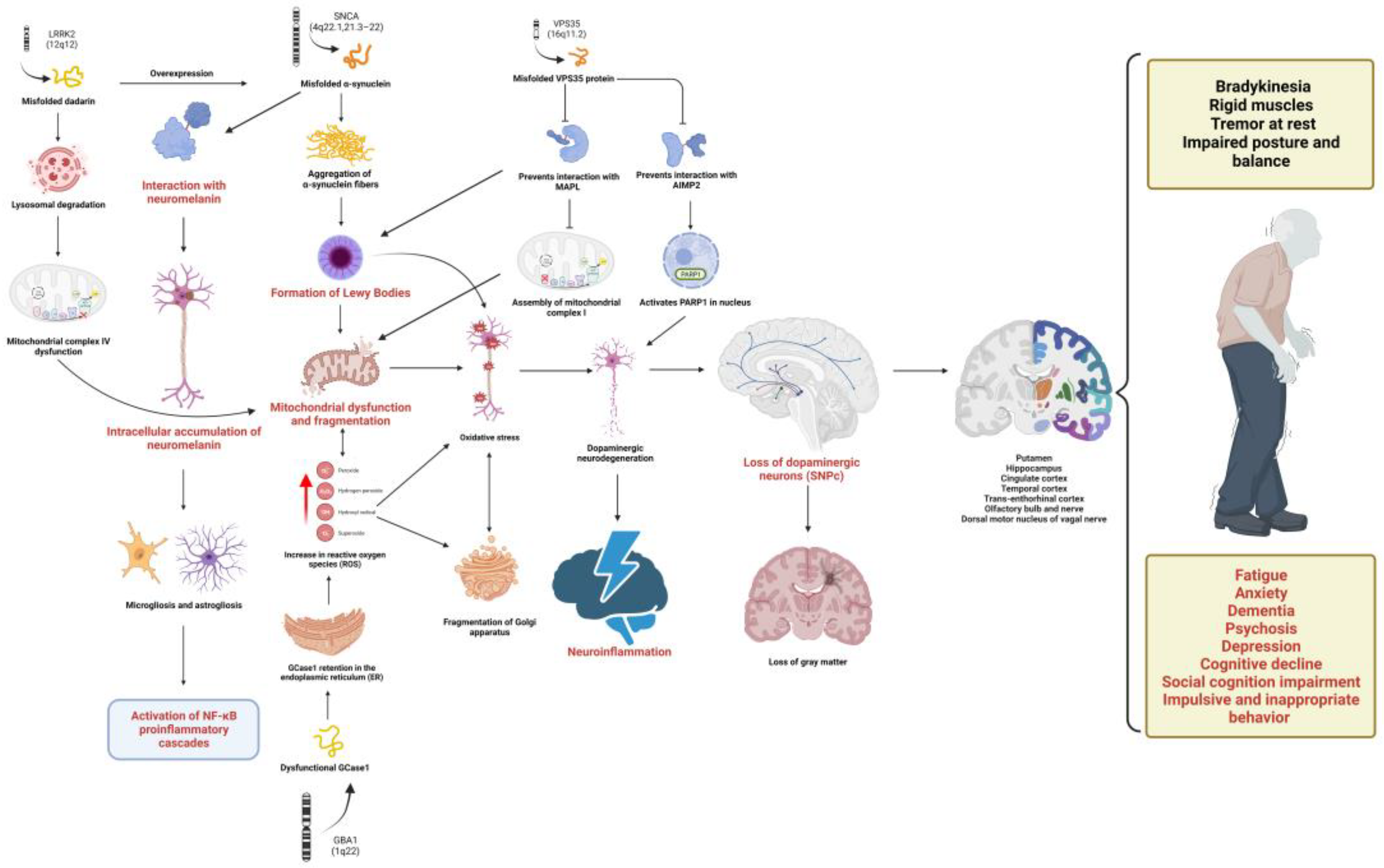
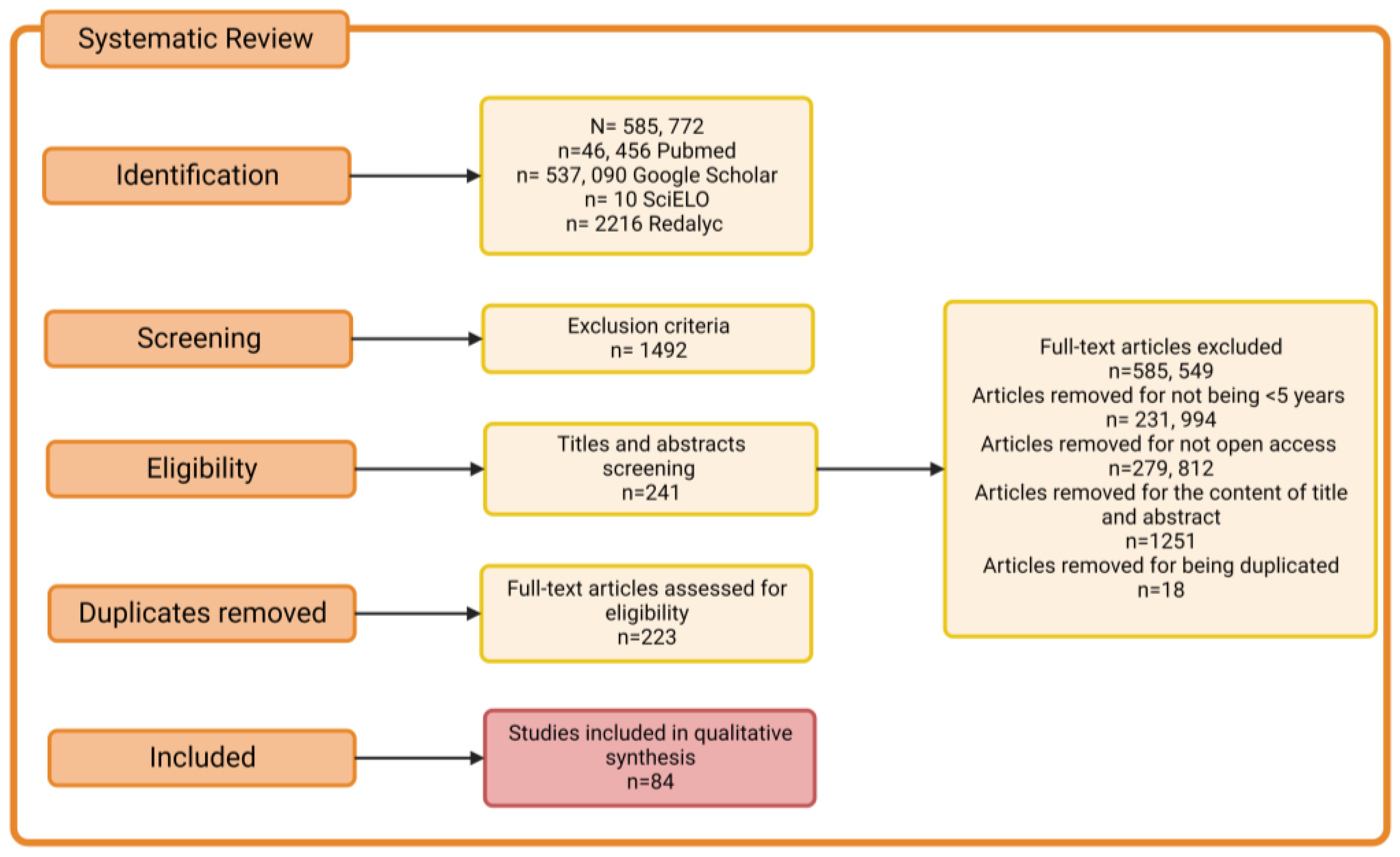
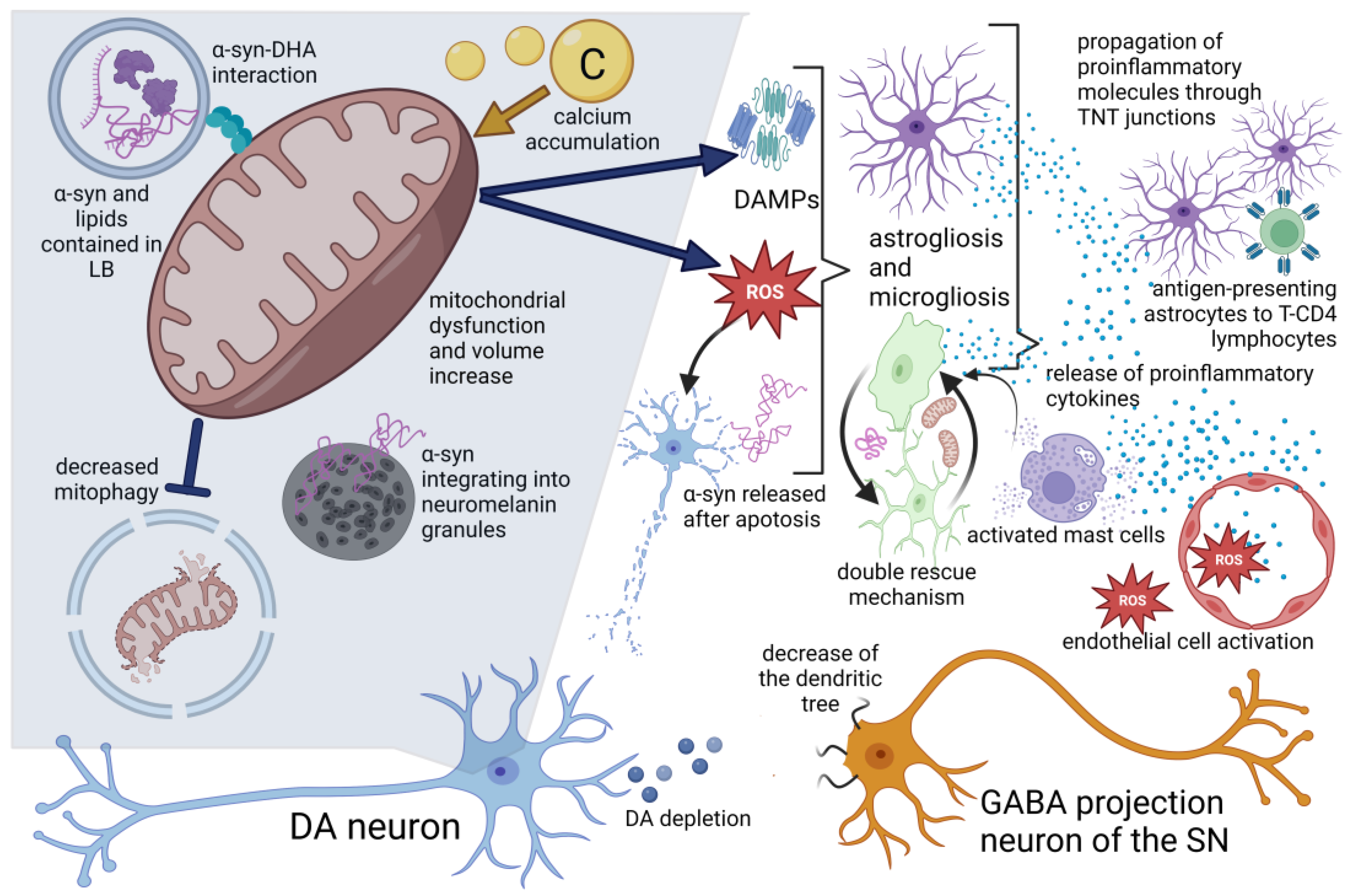
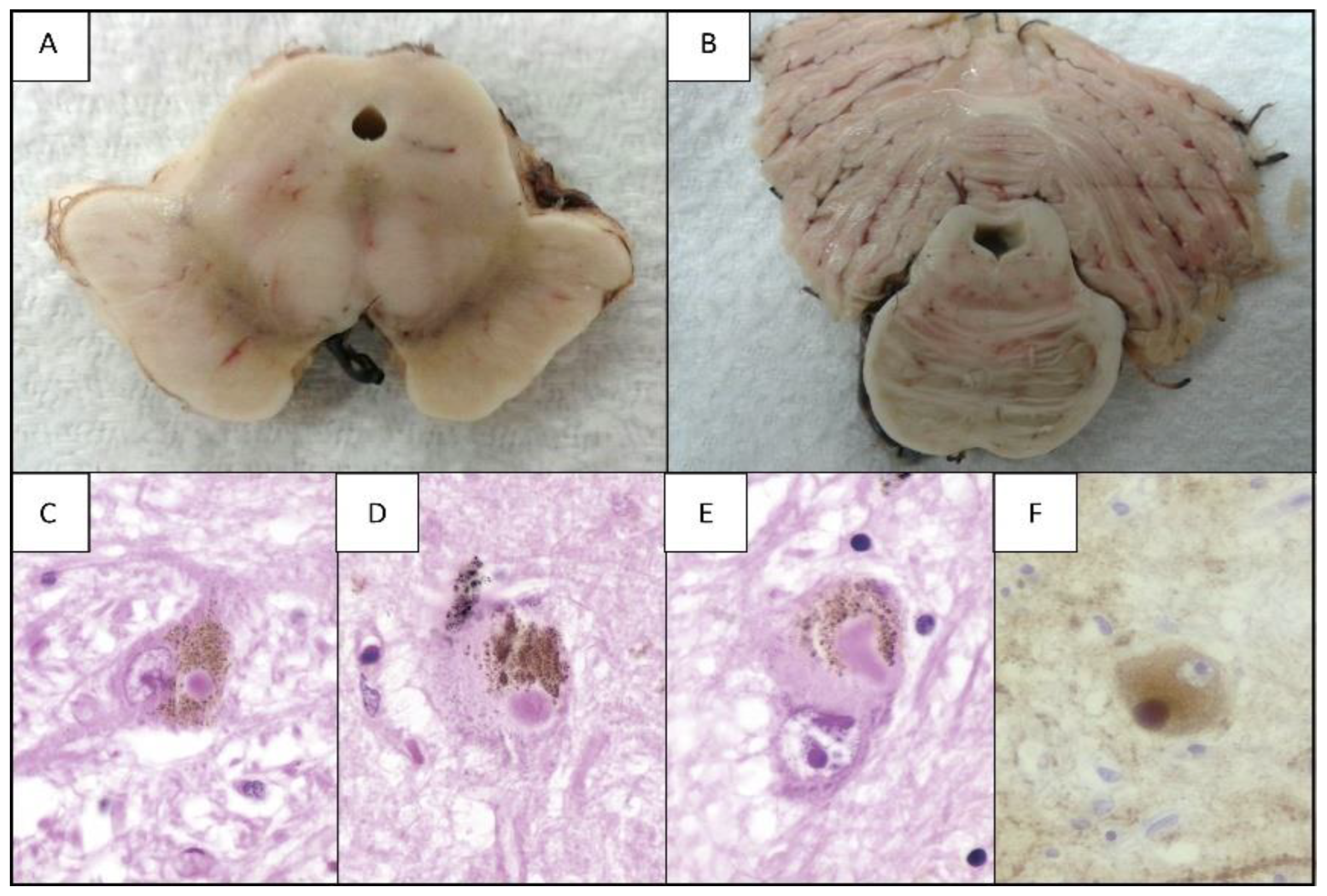
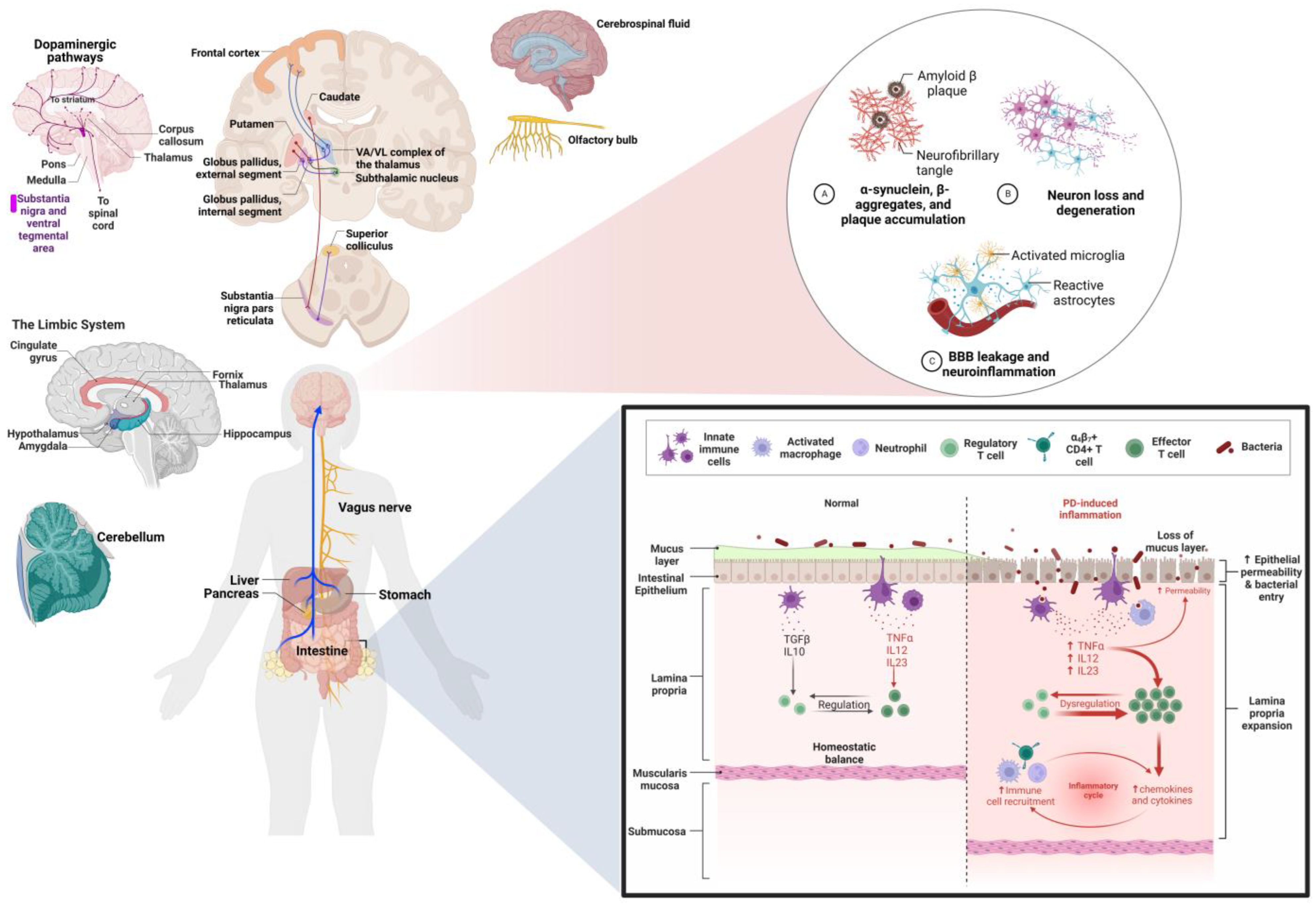
| Inclusion Criteria | Intra-Search Engine Exclusion Criteria | Inter-Search Engine Exclusion Criteria | Total of Articles | ||||||
|---|---|---|---|---|---|---|---|---|---|
| Topics to be covered | Search engine | Booleans | Initial articles | <5 years | open access | first 10 pages of results | title and content | no duplicate articles | articles cited in this paper |
| Genetic and molecular alterations of Parkinson’s Disease associated with neuroinflammation | PubMed | ((Molecular basis) OR (genetic basis)) AND (Parkinson’s disease) | 1442 | 474 | 319 | 100 | 37 | 223 | 84 |
| Google Scholar | 387,000 | 267,000 | 17,000 | 100 | 38 | ||||
| SciELO | 1 | 0 | 0 | 0 | 0 | ||||
| Redalyc | 716 | 117 | 100 | 100 | 4 | ||||
| Cellular and tissue alterations of Parkinson’s Disease associated with neuroinflammation | PubMed | Parkinson’s disease [title] AND neuroinflammation [all fields] AND tissue alterations [all fields] OR cellular alterations [all fields] | 1397 | 344 | 201 | 100 | 5 | ||
| parkinson’s disease [title] AND AND brain tissue [all fields] | 2 | 1 | 1 | 1 | 1 | ||||
| Parkinson’s disease [title] AND neuroinflammation [all fields] AND cell culture [all fields] | 35 | 27 | 18 | 18 | 12 | ||||
| Google Scholar | Parkinson’s disease [title] AND neuroinflammation [all fields] AND tissue alterations [all fields] OR cellular alterations [all fields] | 17,700 | 15,200 | 11,900 | 100 | 25 | |||
| Parkinson’s disease [title] AND neuroinflammation [all fields] AND cell culture [all fields] | 16,800 | 15,800 | 15,600 | 100 | 22 | ||||
| SciELO | (Parkinson’s disease) AND (neuroinflammation) | 6 | 4 | 4 | 4 | 1 | |||
| Redalyc | Parkinson’s disease AND neuroinflammation AND cells OR tissue | 88 | 36 | 33 | 1 | 1 | |||
| Anatomopathological alterations of Parkinson’s Disease associated with neAnatomopathological alterations of Parkinson’s Disease associated with neuroinflammation | PubMed | ((Parkinson’s disease) AND (pathology)) AND (neuroinflammation) | 1796 | 1016 | 654 | 100 | 20 | ||
| (((Parkinson’s disease) AND (alterations)) AND (post-mortem)) AND (inflammation) | 17 | 8 | 7 | 7 | 5 | ||||
| ((((Parkinson’s disease) AND (alterations)) AND (anatomy)) AND (pathology)) AND (inflammation) | 243 | 114 | 78 | 78 | 6 | ||||
| Google Scholar | (((Parkinson’s disease) AND (alterations)) AND (post-mortem)) AND (inflammation) | 19,900 | 17,100 | 100 | 100 | 3 | |||
| SciELO | ((Parkinson’s disease) AND (pathology)) AND (neuroinflammation) | 1 | 1 | 1 | 1 | 1 | |||
| Redalyc | ((Parkinson’s disease) AND (anatomopathological)) | 318 | 80 | 80 | 80 | 12 | |||
| Behavioral alterations of Parkinson’s Disease and lifestyles associated with neuroinflammation | PubMed | parkinson AND (behavior OR neuroinflammation) | 38,486 | 14,663 | 8037 | 100 | 23 | ||
| parkinson AND (karnofsky OR neuroinflammation) NOT alzheimer | 3038 | 1771 | 1054 | 100 | 8 | ||||
| Google Scholar | “parkinson’s disease” AND behavior | 91,900 | 18,100 | 17,300 | 100 | 9 | |||
| “parkinson’s disease” AND “lifestyle changes” | 3790 | 1630 | 1170 | 100 | 3 | ||||
| SciELO | parkinson AND behavior | 2 | 2 | 2 | 2 | 0 | |||
| Redalyc | parkinson AND behavior | 1094 | 290 | 290 | 100 | 5 | |||
| Genes Associated with Autosomal Dominant Parkinson’s Disease | |||||
|---|---|---|---|---|---|
| Gene | locus | Protein | Genetic Variant | Localization | Pathogenesis in PD |
| SNCA | PARK1 | α-synuclein | A53T, A30P, E46K, H50Q, G51D and A53E | 4q22.1 | Oxidative stress, mitochondrial dysfunction and neuroinflammation. |
| PARK4 | 4q21.3-22 | ||||
| UCHL1 | PARK5 | Ubiquitin C-terminal hydrolase L1 | I93M | 4p13-4p14 | Uncertain association. |
| LRRK2 | PARK8 | Repetition of leucine-rich kinase 2 | G2019S, I2020T, I2012T, R1441C, R1441G, R1441H, Y1699C | 12q12 | Mitochondrial dysfunction, excitotoxicity, oxidative stress oxidative stress |
| GIGYF2 | PARK11 | GRB10 interacting with GYF2 protein | N457T, N56S, K421R | 2q36-37 | Uncertain association. |
| HTRA2 | PARK13 | HtrA Serine Peptidase 2 | A141S, G399S, R404W | 2p13.1 | Uncertain association. |
| EIF4G1 | PARK18 | Eukaryotic translation initiation factor 4 Gamma 1 | A502V, G686C, R1205H | 3q27.1 | Defects in the initiation of mRNA translation |
| VPS35 | PARK17 | VPS35 retromer complex component | D686N | 16q11.2 | Oxidative stress, mitochondrial dysfunction and neuroinflammation. |
| DNAJC13 | PARK21 | DnaJC Heat shock protein family (Hsp40) Member 13 | N855S | 3q22.1 | Dysfunction of endosomal traffic. Decreased exocytosis |
| CHCHD2 | PARK22 | Mitochondrial nuclear retrograde regulator 1 | T61I, R145Q | 7p11.2 | Uncertain association. |
| PSAP | PARK24 | Prosaposin | C509S | 10q22.1 | Lysosomal dysfunction |
| Genes Associated with Autosomal Recessive Parkinson’s Disease | |||||
|---|---|---|---|---|---|
| Gene | locus | Protein | Genetic Variant | Localization | Pathogenesis in PD |
| PRKN | PARK2 | Parkin | R42P, R46P, K211N, C212Y, C253Y, C289G and C441R | 6q25.2-q27 | Mitochondrial dysfunction and mitophagy |
| PINK1 | PARK6 | PTEN-induced putative kinase 1 | G411S, I368N, Q456X, A168P, H271Q, L347P and G309D | 1p36.12 | Oxidative stress, mitochondrial dysfunction and neuroinflammation. |
| DJ-1 | PARK7 | DJ-1 Protein | L166P | 1p36.23 | Oxidative stress, mitochondrial dysfunction Lysosomal dysfunction |
| ATP13A2 | PARK9 | ATPase 13A2 | T12M, G533R, F182L, G504R, A746T M810R, G877R | 1p36 | Mitochondrial dysfunction and mitophagy |
| PLA2G6 | PARK14 | Phospholipase A2 Group VI | D331Y, R635Q, R741Q, R747W | 22q13.1 | Uncertain association. |
| FBXO7 | PARK15 | F-Box 7 Protein | Not identified | 22q12-q13 | Uncertain association. |
| DNAJC6 | PARK19 | DnaJ Heat shock protein family (Hsp40) Member C6 | Q789X, R927G | 1p31.3 | Uncertain association Endocytic/lysosomal pathway defect |
| SYNJ1 | PARK20 | Synaptojanin 1 | R258Q, R459P | 21q22.11 | Dysfunction in autophagy |
| VPS13C | PARK23 | Classification of vacuolar proteins 13 Homolog C | Not identified | 15q22.2 | Mitochondrial dysfunction |
| Genes Linked as Risk Factors for Autosomal Dominant PD | ||||||
|---|---|---|---|---|---|---|
| POLG | DNA polymerase gamma, catalytic subunit | Not identified | Frameshift | 15q26.1 | Uncertain association. | 2004 |
| GBA1 | Glucosylceramidase β-1 | N370S and L444P | Nonsense | 1q22 | Lysosomal pathway dysfunction Autophagy alteration | 2009 |
| TMEM230 | transmembrane protein 230 | R141L | Nonsense | 20p13 | Oxidative stress, mitochondrial dysfunction and neuroinflammation. | 2016 |
| LRP10 | LDL receptor-related protein 10 | Not identified | Nonsense | 14q11.2 | Uncertain association. | 2016 |
Disclaimer/Publisher’s Note: The statements, opinions and data contained in all publications are solely those of the individual author(s) and contributor(s) and not of MDPI and/or the editor(s). MDPI and/or the editor(s) disclaim responsibility for any injury to people or property resulting from any ideas, methods, instructions or products referred to in the content. |
© 2023 by the authors. Licensee MDPI, Basel, Switzerland. This article is an open access article distributed under the terms and conditions of the Creative Commons Attribution (CC BY) license (https://creativecommons.org/licenses/by/4.0/).
Share and Cite
Castillo-Rangel, C.; Marin, G.; Hernández-Contreras, K.A.; Vichi-Ramírez, M.M.; Zarate-Calderon, C.; Torres-Pineda, O.; Diaz-Chiguer, D.L.; De la Mora González, D.; Gómez Apo, E.; Teco-Cortes, J.A.; et al. Neuroinflammation in Parkinson’s Disease: From Gene to Clinic: A Systematic Review. Int. J. Mol. Sci. 2023, 24, 5792. https://doi.org/10.3390/ijms24065792
Castillo-Rangel C, Marin G, Hernández-Contreras KA, Vichi-Ramírez MM, Zarate-Calderon C, Torres-Pineda O, Diaz-Chiguer DL, De la Mora González D, Gómez Apo E, Teco-Cortes JA, et al. Neuroinflammation in Parkinson’s Disease: From Gene to Clinic: A Systematic Review. International Journal of Molecular Sciences. 2023; 24(6):5792. https://doi.org/10.3390/ijms24065792
Chicago/Turabian StyleCastillo-Rangel, Carlos, Gerardo Marin, Karla Aketzalli Hernández-Contreras, Micheel Merari Vichi-Ramírez, Cristofer Zarate-Calderon, Osvaldo Torres-Pineda, Dylan L. Diaz-Chiguer, David De la Mora González, Erick Gómez Apo, Javier Alejandro Teco-Cortes, and et al. 2023. "Neuroinflammation in Parkinson’s Disease: From Gene to Clinic: A Systematic Review" International Journal of Molecular Sciences 24, no. 6: 5792. https://doi.org/10.3390/ijms24065792
APA StyleCastillo-Rangel, C., Marin, G., Hernández-Contreras, K. A., Vichi-Ramírez, M. M., Zarate-Calderon, C., Torres-Pineda, O., Diaz-Chiguer, D. L., De la Mora González, D., Gómez Apo, E., Teco-Cortes, J. A., Santos-Paez, F. d. M., Coello-Torres, M. d. l. Á., Baldoncini, M., Reyes Soto, G., Aranda-Abreu, G. E., & García, L. I. (2023). Neuroinflammation in Parkinson’s Disease: From Gene to Clinic: A Systematic Review. International Journal of Molecular Sciences, 24(6), 5792. https://doi.org/10.3390/ijms24065792








